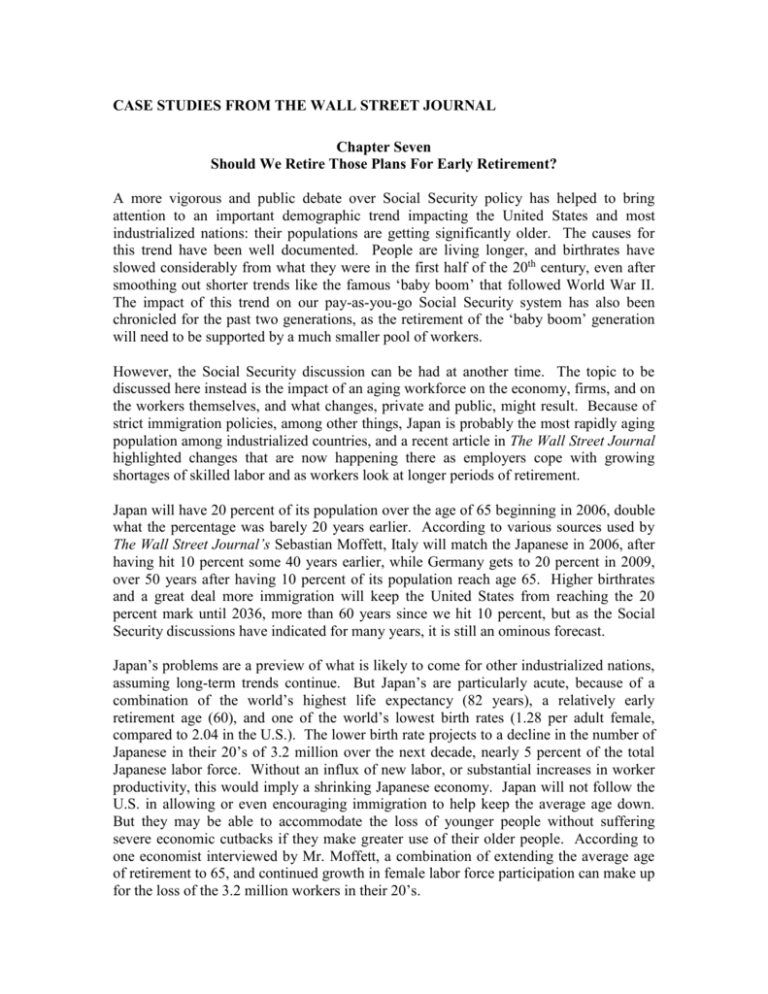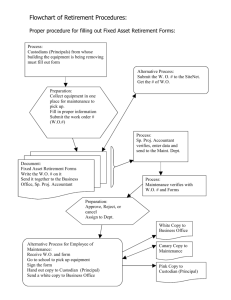Plans For Early Retirement
advertisement

CASE STUDIES FROM THE WALL STREET JOURNAL Chapter Seven Should We Retire Those Plans For Early Retirement? A more vigorous and public debate over Social Security policy has helped to bring attention to an important demographic trend impacting the United States and most industrialized nations: their populations are getting significantly older. The causes for this trend have been well documented. People are living longer, and birthrates have slowed considerably from what they were in the first half of the 20th century, even after smoothing out shorter trends like the famous ‘baby boom’ that followed World War II. The impact of this trend on our pay-as-you-go Social Security system has also been chronicled for the past two generations, as the retirement of the ‘baby boom’ generation will need to be supported by a much smaller pool of workers. However, the Social Security discussion can be had at another time. The topic to be discussed here instead is the impact of an aging workforce on the economy, firms, and on the workers themselves, and what changes, private and public, might result. Because of strict immigration policies, among other things, Japan is probably the most rapidly aging population among industrialized countries, and a recent article in The Wall Street Journal highlighted changes that are now happening there as employers cope with growing shortages of skilled labor and as workers look at longer periods of retirement. Japan will have 20 percent of its population over the age of 65 beginning in 2006, double what the percentage was barely 20 years earlier. According to various sources used by The Wall Street Journal’s Sebastian Moffett, Italy will match the Japanese in 2006, after having hit 10 percent some 40 years earlier, while Germany gets to 20 percent in 2009, over 50 years after having 10 percent of its population reach age 65. Higher birthrates and a great deal more immigration will keep the United States from reaching the 20 percent mark until 2036, more than 60 years since we hit 10 percent, but as the Social Security discussions have indicated for many years, it is still an ominous forecast. Japan’s problems are a preview of what is likely to come for other industrialized nations, assuming long-term trends continue. But Japan’s are particularly acute, because of a combination of the world’s highest life expectancy (82 years), a relatively early retirement age (60), and one of the world’s lowest birth rates (1.28 per adult female, compared to 2.04 in the U.S.). The lower birth rate projects to a decline in the number of Japanese in their 20’s of 3.2 million over the next decade, nearly 5 percent of the total Japanese labor force. Without an influx of new labor, or substantial increases in worker productivity, this would imply a shrinking Japanese economy. Japan will not follow the U.S. in allowing or even encouraging immigration to help keep the average age down. But they may be able to accommodate the loss of younger people without suffering severe economic cutbacks if they make greater use of their older people. According to one economist interviewed by Mr. Moffett, a combination of extending the average age of retirement to 65, and continued growth in female labor force participation can make up for the loss of the 3.2 million workers in their 20’s. A combination of private efforts and public policy changes is seeking to bring about that result. Japan is now gradually raising the age for eligibility for full public pensions, from 60 in 2000 to 65 in 2025, and perhaps forecasting Social Security changes in the U.S., anticipates raising worker premiums and reducing benefits. Japan has also passed a law requiring companies to raise their retirement age to 65. According to Mr. Moffett, there is much opposition to this from Japan’s larger companies, and the law will not impose penalties for non-compliance. Even the larger companies, who have a longstanding tradition of not laying off workers and worry about losing flexibility to reduce their workforce through retirement, have concerns about losing many of their skilled workers, and perhaps some of the hard work ethic of the current pre-retirement generation. Many smaller companies are already well ahead of the new law, merely pursuing their own self-interest by retaining and hiring older workers to help alleviate labor shortages and retain valuable workers. Many older Japanese workers, meanwhile, seem to be quite happy about the changes. Citing data from the International Labor Organization, Mr. Moffett reports that 71 percent of Japanese men between ages 60-64 currently work, despite the official retirement age of 60. That compares with only 57 percent of American men where the retirement age is generally considered to be 65 (for full eligibility for Social Security benefits), and 17 percent of French men, where retirement age is 60. An international survey asking about the ‘ideal’ retirement age found Japanese respondents tending to list 65 or 70, while their American and European counterparts tended to list 60 or 65. An important dimension to this change raised by Mr. Moffett is the need for firms to evaluate their work processes to accommodate the needs and limitations of older workers. Despite a reputation for longevity and good health, particularly in production work, it will be important for firms to use automation and design changes to reduce the demands on older workers to do heavy lifting, lots of bending over, or standing in place for long periods of time. Source: “Senior Moment: Fast-Aging Japan Keeps Its Elders On the Job Longer,” by Sebastian Moffett, The Wall Street Journal, June 15, 2005 (pp. A1, A8). 7a. What factors go into an individual’s decision to retire? Drawing from the information presented in this case study, how, if at all, have any of these factors changed? 7b. As improved health leads to longer life expectancy, are there any economic reasons for why Americans should expect to enjoy most of those increased years in retirement, or why they should spend most of them working? 7c. Japan, unlike the U.S., does not have laws preventing discrimination based on age. If greater numbers of older workers choose remain in the work force in the U.S., should anti-discrimination protections be increased, or should they be decreased so that older workers don’t deprive younger workers of opportunities?







